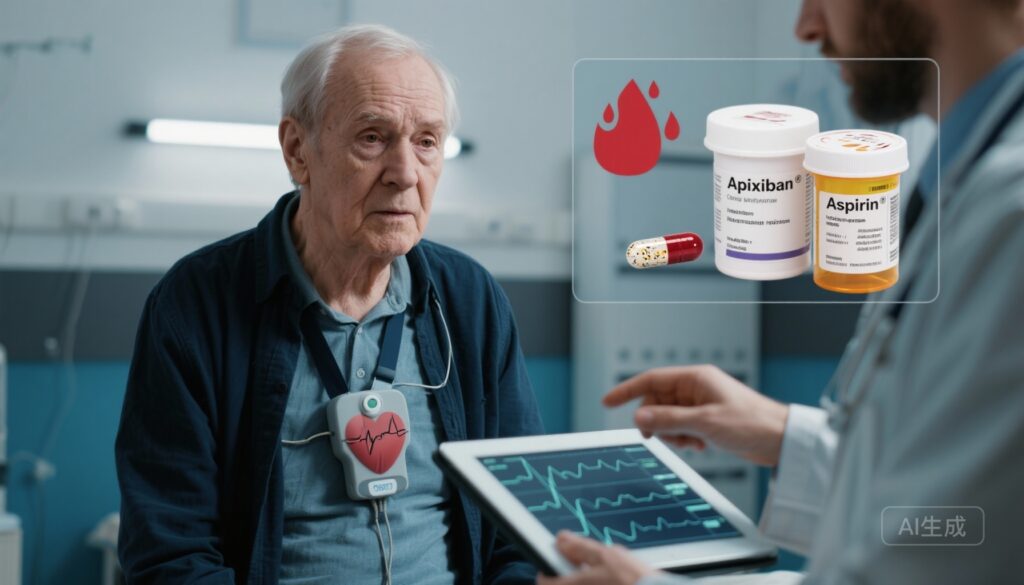Highlight
– In patients with device-detected subclinical atrial fibrillation (SCAF), apixaban increased major bleeding compared with aspirin (HR 1.80; 95% CI, 1.26–2.57) over ~3.5 years, driven largely by gastrointestinal bleeding (HR 2.23; 95% CI, 1.32–3.78).
– Rates of intracranial and fatal bleeding were not higher with apixaban versus aspirin; apixaban-treated bleeds were less likely to be at critical sites.
– Most major bleeding episodes were nonemergent and defined mainly by hemoglobin drop ≥2 g/dL; NSAID use, cancer, apixaban allocation, and older age were independent bleeding predictors.
Background
Subclinical atrial fibrillation (SCAF), detected increasingly by cardiac implantable electronic devices and wearable monitors, is associated with heightened thromboembolic risk in observational studies. Whether and when to anticoagulate patients with SCAF remains a major unmet clinical question because the population tends to be older and carry bleeding risk factors. The ARTESiA randomized trial directly evaluated apixaban versus aspirin in patients with device-detected SCAF and elevated stroke risk; the main trial finding (apixaban reduced stroke/systemic embolism but increased major bleeding) raises important questions about the character and predictors of bleeding that influence net clinical benefit.
Study design
Design and population
This prespecified subanalysis used ARTESiA trial data. ARTESiA was an international, double-blind, double-dummy randomized clinical trial enrolling patients with at least one episode of device-detected SCAF lasting 6 minutes to 24 hours, and with stroke risk reflected by CHA2DS2-VASc score ≥3 (or prior stroke). The analysis population included 3,961 treated patients (mean age 76.8 years; 64% men). Mean follow-up was 3.5 (SD 1.8) years.
Interventions and endpoints
Participants were randomized to apixaban 5 mg twice daily (2.5 mg twice daily if dose-reduction criteria applied) or aspirin 81 mg once daily. The primary safety outcome for this subanalysis was major bleeding adjudicated by an independent, blinded committee using International Society on Thrombosis and Hemostasis (ISTH) criteria (which include fatal bleeding, symptomatic bleeding in a critical area/organ, or bleeding causing hemoglobin drop ≥2 g/dL or requiring ≥2 units transfusion).
Key findings
Overall major bleeding risk
During follow-up, 133 patients experienced one or more major bleeding events: 86 of 1,989 randomized to apixaban and 47 of 1,972 randomized to aspirin. Event rates were 1.71 vs 0.94 major bleeds per 100 patient-years for apixaban and aspirin, respectively (hazard ratio [HR] 1.80; 95% CI, 1.26–2.57), confirming a statistically and clinically relevant increase in major bleeding with apixaban in this SCAF population.
Bleeding site and severity
– Intracranial bleeding: Similar rates between apixaban and aspirin (0.33 vs 0.40 per 100 patient-years; HR 0.82; 95% CI, 0.43–1.57).
– Fatal bleeding: No significant difference (0.10 vs 0.16 per 100 patient-years; HR 0.63; 95% CI, 0.20–1.91).
– Gastrointestinal (GI) bleeding: Higher rate with apixaban (0.89 vs 0.40 per 100 patient-years; HR 2.23; 95% CI, 1.32–3.78) and appears to be the major driver of the excess major bleeding risk.
Notably, among the 133 index major bleeding events, those occurring on apixaban were less likely to involve critical anatomic sites (27.9% [24/86] vs 46.8% [22/47]; P = .03). Intracranial involvement was numerically and statistically lower with apixaban among index events (18.6% [16/86] vs 42.6% [20/47]; P = .003), consistent with prior NOAC data showing lower intracranial hemorrhage versus vitamin K antagonists, and here compared with aspirin.
Clinical presentation
Most major bleeding episodes were not acute, catastrophic hemorrhages but rather nonemergent events characterized by a hemoglobin drop ≥2 g/dL—findings that inform triage and management strategies (for example, close monitoring and diagnostic evaluation rather than immediate invasive intervention in some cases).
Independent predictors of major bleeding
Multivariable analysis identified the following factors associated with higher major bleeding risk:
– Concomitant nonsteroidal anti-inflammatory drug (NSAID) use: HR 10.25; 95% CI, 6.57–15.99.
– Active cancer: HR 2.87; 95% CI, 1.49–5.53.
– Randomization to apixaban: HR 1.84; 95% CI, 1.29–2.63.
– Increasing age: HR 1.47 per 5-year increment; 95% CI, 1.28–1.67.
The extraordinarily strong association with NSAID use is notable and clinically actionable—NSAIDs are modifiable contributors to bleeding risk and frequently overused in older adults for analgesia.
Expert commentary and interpretation
This subanalysis refines our understanding of the safety trade-offs when treating SCAF with full-dose anticoagulation. Key interpretive points:
– Nature of bleeding matters: Although apixaban increased the overall major bleeding rate, the excess was concentrated in gastrointestinal events rather than intracranial or fatal hemorrhage. For clinicians, this distinction changes risk counseling and the urgency of intervention when bleeds occur.
– Modifiable risk factors are high-value targets: The very high HR for NSAID-associated bleeding emphasizes the importance of medication review and avoidance of NSAIDs in patients considered for anticoagulation. Where analgesia is required, alternative agents (acetaminophen or non-NSAID strategies) and careful gastroprotection should be prioritized.
– Patient selection and individualized benefit–risk: ARTESiA demonstrated apixaban reduced stroke/systemic embolism in SCAF but at the cost of more major bleeding. The present subanalysis helps refine shared decision-making: patients at elevated GI bleeding risk (prior peptic ulcer disease, active cancer, concomitant NSAIDs) or advanced age may derive less favorable net benefit. Conversely, patients at high ischemic risk but low modifiable bleeding risk may favor anticoagulation.
– Role of gastroprotection: Although ARTESiA did not randomize PPI use, existing guideline statements and observational data support proton pump inhibitor co-prescription for patients on anticoagulants with high upper-GI bleeding risk. Such strategies may mitigate the GI bleeding excess seen with apixaban; prospective data in SCAF would be valuable.
Clinical implications
When considering anticoagulation for SCAF, clinicians should:
– Conduct an individualized assessment of ischemic and bleeding risks, integrating CHA2DS2-VASc, age, cancer status, and medication review.
– Avoid NSAIDs whenever possible in patients who are anticoagulated; counsel patients and coordinate with primary care and pain management.
– Consider gastroprotective strategies (e.g., PPI) for patients with prior GI bleeding or other upper-GI risk factors, per guideline recommendations.
– Counsel patients that most major bleeds in ARTESiA were nonemergent hemoglobin drops rather than catastrophic intracranial hemorrhages, which may inform preferences about anticoagulation trade-offs.
Limitations and generalizability
– Subanalysis context: Findings are from a prespecified subanalysis of a randomized trial; while adjudication and methodology are rigorous, some analyses are observational within the randomized cohort.
– Population characteristics: The cohort was older (mean 76.8 years) and predominantly male (64%); results may not generalize to substantially younger populations or those with different comorbidity profiles.
– Comparator choice: Aspirin was the comparator rather than placebo. Prior trials suggest aspirin provides limited stroke prevention benefit with its own bleeding risk; the choice of aspirin affects interpretation of absolute and relative harms and benefits.
– NSAID association: The striking HR for NSAID use likely includes residual confounding and may reflect incomplete capture of over-the-counter use; nonetheless, the signal is consistent with known pharmacology and population-level data.
– Power for rare outcomes: Although overall sample size is substantial, event counts for fatal and intracranial bleeding were small, limiting precision for these outcomes.
Conclusions
This ARTESiA subanalysis informs the nuanced clinical calculus for anticoagulation in SCAF. Apixaban increased overall major bleeding relative to aspirin, driven predominantly by gastrointestinal events; however, rates of intracranial and fatal bleeding were similar and index bleeds on apixaban were less likely to be at critical sites. Modifiable factors—most notably NSAID use—substantially influenced bleeding risk and should be a focus of pre-anticoagulation optimization. These data reinforce the need for individualized decision-making and suggest that bleeding-risk mitigation strategies (medication review, gastroprotection) are crucial when anticoagulating older patients with device-detected SCAF.
Funding and trial registration
ARTESiA was registered at ClinicalTrials.gov (NCT01938248). Detailed funding sources are reported in the primary trial and subanalysis publications (see reference).
References
1. Siegal DM, Sticherling C, Healey JS, et al. Major Bleeding With Apixaban vs Aspirin: A Subanalysis of the ARTESiA Randomized Clinical Trial. JAMA Cardiol. 2025 Nov 12:e254151. doi:10.1001/jamacardio.2025.4151. PMID: 41222953; PMCID: PMC12613090.
2. Granger CB, Alexander JH, McMurray JJV, et al.; ARISTOTLE Committees and Investigators. Apixaban versus warfarin in patients with atrial fibrillation. N Engl J Med. 2011;365(11):981–992. doi:10.1056/NEJMoa1107039.
3. Healey JS, Connolly SJ, Gold MR, et al. Subclinical atrial fibrillation and the risk of stroke. N Engl J Med. 2012;366(2):120–129. doi:10.1056/NEJMoa1105575.
4. Schulman S, Kearon C. Definition of major bleeding in clinical investigations of antihemostatic medicinal products in non-surgical patients. J Thromb Haemost. 2005;3(4):692–694. doi:10.1111/j.1538-7836.2005.01204.x.
5. Kirchhof P, Benussi S, Kotecha D, et al.; ESC Scientific Document Group. 2020 ESC Guidelines for the diagnosis and management of atrial fibrillation developed in collaboration with the European Association for Cardio-Thoracic Surgery (EACTS). Eur Heart J. 2020; 42: 373–498. doi:10.1093/eurheartj/ehaa612.



